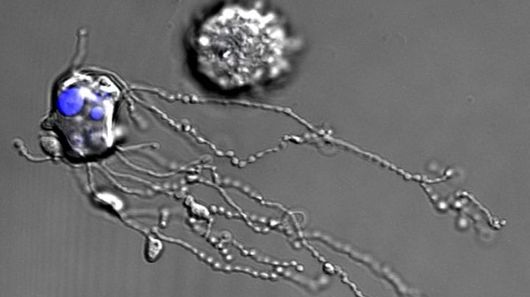
With a pivotal role in fending off infections and disease, white blood cells are the engine room of the body's immune system. But little was known about what happens exactly when these cells reach the end of their life cycles. Scientists have now captured the death of white blood cells on camera for the first time, showing that they eject much of their contents while decomposing. One reason for this could be to warn neighboring cells of dangerous pathogens in the area. The researchers say learning more about their expiration could help bring about improved health treatments in the future.
With a pivotal role in fending off infections and disease, white blood cells are the engine room of the body's immune system. But little was known about what happens exactly when these cells reach the end of their life cycles. Scientists have now captured the death of white blood cells on camera for the first time, showing that they eject much of their contents while decomposing. One reason for this could be to warn neighboring cells of dangerous pathogens in the area. The researchers say learning more about their expiration could help bring about improved health treatments in the future.
"The role of white blood cells is central to our body's innate immune system and much like fighter jet pilots are ejected from their downed aeroplane, we have discovered certain molecules are pushed free from the dying cell, while others are left behind in the 'wreckage' of the cell fragments," says Dr Ivan Poon from the School of Molecular Sciences at Melbourne's La Trobe University.
Poon and other La Trobe researchers worked with scientists from the University of Virginia in exploring the demise of the body's white blood cells. The team used a technique known as time-lapse microscopy, where images are snapped with a microscope and played in sequence to create a video.
What this video revealed came as a surprise to the researchers, in that the sequence of events was much more methodical than previously thought. They saw proteins involved in signal transfer, cell growth and maintenance arrange in necklace-like string of beads and shot out from a dying monocyte cell.
The scientists have dubbed these strings "beaded apoptodia" and report them to be as much as eight times the length of the host cell. But the purpose they serve exactly is not yet known. A warning system whereby nearby white blood cells are alerted to the presence of harmful infections is one theory they have posited. Another is it could actually facilitate the spread of a virus to other parts of the body.
"It is the first time we have ever seen this take place and we now need to better understand the reasons behind this and the implications of this process of cell fragmentation," says Poon.
Despite the current uncertainty, the scientists say that discovering more about the mechanics of white blood cell death will be valuable going forward. They hope that it will enable them to better harness the body's own defence and healing capabilities and in turn lead to better future health treatments. The video can be seen via the source link below.

 Previous page
Previous page Back to top
Back to top







